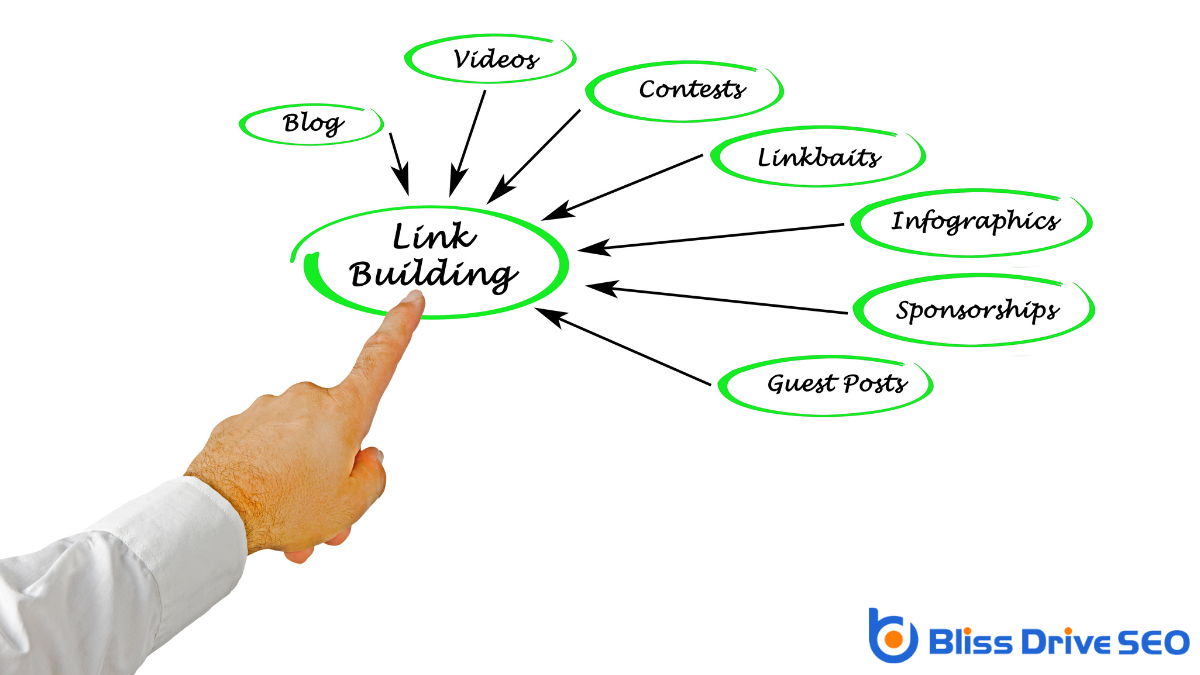Digital Marketing Services
Learn More About Us

Starting with link buildingThe process of acquiring backlinks from other websites. can seem overwhelming, but breaking it down into manageable steps makes it achievable. First, you'll want to comprehend your audience and pinpoint what they find valuable. This insight guides you in developing linkable assets that naturally attract attention. Next, analyze your competitors' links to learn from their successes. Outreach isn't just about sending emails—it's about building genuine relationships. Social media can also enhance your efforts if used strategically. But how do you guarantee your links remain beneficial over time? There's an essential aspect yet to discuss that will safeguard your strategy's success.
Understanding your audience is essential because it lays the foundation for effective link-building. When you know who you're targeting, you can tailor your strategies to meet their needs and preferences. Start by identifying your audience's demographics, interests, and online behavior.
What type of content do they consume? Which platforms do they frequent? By answering these questions, you can create content that resonates with them and is more likely to be shared, linked, and referenced by others.
Next, develop a clear understanding of the problems your audience faces and how your content can provide solutions. When your content addresses their needs, you're more likely to attract natural backlinks from other sites seeking valuable resources for their readers.
Additionally, consider engaging directly with your audience through surveys, interviews, or social media interactions. These insights can guide your content creation process, ensuring that what you publish is relevant and engaging.

To effectively build links, start by identifying your top competitors in the industry.
Analyze their backlink profiles to understand where they're gaining their link equity.
This will help you discover valuable link opportunities that you can leverage for your own strategy.
When starting a link-building strategy, identifying your top competitors is a crucial initial step. Understanding who you're up against gives you insights into what's working in your nicheA specific segment of the market targeted by affiliates to promote products or services. and who you should watch. Begin by pinpointing businesses that rank highly for the same keywordsWords or phrases that users type into search engines to find information. you're targeting. These are likely your top competitors, and analyzing them can reveal valuable opportunities.
Use search engines to type in your primary keywords and see which companies consistently appear in the top positions. Compile a list of these sites, as they're clearly doing something right. Additionally, tools like SEMrush or Ahrefs can be invaluable. They provide detailed information on competitor rankingsThe position at which a website appears in the SERP. and can help you identify even more players in your field.
Don't just focus on direct competitors; consider indirect ones, too. These are sites that mightn't sell the same product but attract the same audience. Understanding their strategies can broaden your perspective.
Once you've identified your primary competitors, you can explore their link-building tactics more deeply. Keep your list focused and manageable to guarantee your efforts are directed effectively. Knowing your competition sets a solid foundation for building a robust link strategy.
How do you gain an edge in your link-building strategy? By analyzing your competitors' backlink profiles, you can uncover valuable insights. Start by identifying who ranks well in your niche. Once you've got your list of top competitors, the next step is diving into their backlink profiles.
Use tools like Ahrefs or SEMrush to see who's linking to them and what domains provide the most authority.
Pay attention to the types of content attracting these links. Are they detailed guides, infographicsVisual representations of information, data, or knowledge intended to present complex information qu..., or industry reports? Understanding the kind of content that draws links can inform your own content strategyA plan for creating, publishing, and managing content to meet business goals..
Look for patterns in their backlinks—is there a specific type of site or industry that frequently links to them?
You should also check the quality of these backlinks. High-quality backlinks come from reputable sites. Avoid spammy links, as they can hurt your site's reputation.
Alongside analyzing competitor backlink profiles, discovering link opportunities demands a strategic approach. Start by researching your competitors' link sources. Use tools like Ahrefs or SEMrush to uncover where their links originate. These platforms provide insights into the domains linking to your competitors, giving you a roadmap of potential sites to target.
Focus on quality over quantity. Identify high-authority sites that could offerThe specific product or service being promoted by affiliates. valuable backlinks to your site. Pay attention to the content of these sites to guarantee they align with your niche. Reaching out to sites relevant to your industry increases the chances of securing a link.
Consider the type of content that attracts links. Competitors' popular content might inspire similar topics for your site. Whether it's a blog post, infographic, or case study, make sure it's engaging and informative.
Don't overlook broken link building. Identify broken links on competitor sites and offer your content as a replacement. This not only helps the site owner but also provides you with a backlink.
Stay persistent and build relationships with site owners. Genuine connections can leadA potential customer referred by an affiliate who has shown interest in the product or service but h... to future link-building opportunities, enhancing your SEO efforts. Remember, discovering link opportunities is a continuous process that requires patience and strategy.

Creating compelling linkable assets is a [IMPORTANT] step in any successful link-building strategy. These assets are valuable content pieces that naturally attract links from other websites.
To start, think about the types of content that resonate with your audience and industry. Infographics, detailed guides, research reports, and interactive tools are popular choices because they offer unique value or insights that others can't easily replicate.
Focus on quality over quantity. Your content should be thoroughly researched, well-written, and visually appealing. It's [CRITICAL] to address specific pain points or questions your target audience may have.
When your content solves problems or provides new insights, it becomes irresistible to linkers.
Consider your audience's preferences and habits. Are they more likely to engage with videos, podcastsAudio content distributed through digital channels, often in series format., or articles? Tailor your assets to fit their consumption style.
Also, keep an eye on trending topics or evergreen contentContent that remains relevant and valuable over a long period. that remains relevant over time. By aligning your content with these trends, you increase the likelihood of earning links.
To succeed in outreach and relationship building, start by identifying target influencers who align with your niche.
Craft personalized messages that show genuine interest in their work, making your outreach stand out.
Focus on building long-term partnerships that benefit both parties, strengthening your link-building strategy over time.
Identifying target influencers is a crucial step in building effective outreach and nurturing meaningful relationships. By focusing on the right influencers, you'll enhance your link-building strategy and extend your network's reach. Start by researching individuals or organizations that align with your niche. They should have an enthusiastic audience that trusts their recommendations.
Here are three steps to help you pinpoint the perfect influencers for your campaignA set of ad groups sharing a budget, targeting options, and other settings.:
Reaching out effectively boils down to crafting personalized messages that resonate with your target influencers. When you take the time to tailor your communication, you show genuine interest and understanding of their work.
Start by researching the influencer's recent projects or contributions. Mentioning these in your message demonstrates that you've done your homework and aren't just sending a generic email.
Use a friendly tone that matches the influencer's style. Address them by name and refer to specific content or insights they've shared. This personal touch sets you apart from others who might be competing for their attention. Remember, influencers appreciate when you recognize their unique voice and value their perspective.
Clearly state your purpose and how your proposal benefits them. Whether you're offering to collaborate, share content, or provide resources, make sure it aligns with their interests and goals. Avoid long-winded explanations; be concise and get straight to the point.
Building long-term partnerships in link building is like nurturing a flourishing garden; the key is consistent care and genuine engagement. Start by identifying potential partners whose interests align with yours. Understanding their content and audience, ensuring a natural partnership, is crucial. Begin with a personalized outreach, showing genuine interest in their work and explaining how a collaboration could be mutually beneficial.
Once you've made initial contact, focus on building trust. Here's how you can do it:

Social media platforms are a goldmine for link-building opportunities, offering countless ways to amplify your content's reach and visibility. By actively engaging with your audience on platforms like FacebookA social networking site where users can post comments, share photographs, and links to news or othe..., TwitterA microblogging and social networking service where users post and interact with messages known as "..., LinkedInA professional networking site used for career and business networking., and InstagramA photo and video-sharing social networking service owned by Facebook., you can't only share your content but also encourage others to do the same. When you create engaging, shareable content, you increase the chances of others linking back to your website.
Start by identifying which platforms your target audience frequents most and focus your efforts there. Share your blog posts, articles, and other valuable content consistently, and don't hesitate to join relevant groups or discussions.
Engaging with influencers in your niche is another effective strategy. By commenting on their posts and sharing their content, you build a relationship that could lead to them linking to your content.
As you engage with your audience on social media, it's important to keep an eye on your link-building progress and make adjustments when needed. Monitoring and adjusting your strategy confirms you're maximizing results and not wasting resources. Here's how you can effectively monitor your link-building efforts:
To excel in link building, you need to understand your audience, research competitor links, and develop valuable linkable assets. Engage in outreach and cultivate relationships, leveraging social media to amplify your efforts. Focus on creating quality content and diverse link sources, always adhering to ethical practices. Regularly monitor your backlink health and adjust your strategy as needed. By following these steps, you'll strengthen your site's visibility and authority, setting the stage for long-term success.
